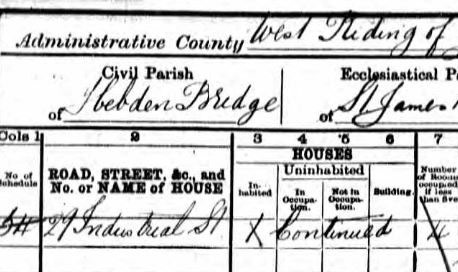Local History Society Report
Life and Death in Hebden Bridge 1851- 1901
Speaker: Anne Mealia
Wednesday, 3 April 2019
For those searching for clues about their family history, census returns, which are collected every ten years and are now available to search on-line, have provided a rich source of information. But the records can also give a picture of a community. Anne Mealia, a genealogist and historical researcher, shared the results of her painstaking and detailed analysis of records for Hebden Bridge from 1851 to 1901. This has enabled her to create a picture of life and death in the town, revealing changes in population, families and occupations over half a century, which sometimes challenge our established ideas about the lives of our forebears.

Population was growing nationally at this time, but there was a steeper rise in Hebden Bridge from 1881, probably caused by people moving to find work. There is a general perception that people didn’t move much in these times. Indeed, more than half of the residents over this period were born either in the town, or in nearby townships, and fewer than 1% came from outside England. But there was hardly a part of the world which was not represented in this small group, with most from Ireland and Scotland, but other individuals born in India, Russia, West Africa and India.
A family named Gibson had three children born in Moscow, where their engineer father had presumably moved for work. We can also see the effects of the British Empire, with three children born in British Honduras (Belize) to a teacher mother also born there, but with the very local name Greenwood. Indeed, the surnames that dominated these census returns – Greenwood, Sutcliffe, Crabtree and Horsfall – are still ones which we associate with Hebden Bridge.
We tend to have an idea of much larger households at this period, but the average household size of about 4.9 fell a little to 4.1 over the fifty years. Non-family members were included in the household totals. The largest household of 17 people was in fact a school at Thorn Bank, which included two governesses and ten boarding scholars.
Ten percent of households had servants living in, and 11 percent had lodgers or boarders. There were also a number of apprentices – stone mason, dressmaker, printer and hairdresser – who lived with their ‘masters’. A small number of people lived alone, but unmarried adult children were quite likely to stay in the family home, such as one mother living with her seven adult offspring. Most families were made up of parents and children, with an average of 5/6 children and here were plenty of examples of three generations living together.
Unsurprisingly, the main occupations in the town were related to the production of cotton or tailoring, but there were some unusual trades. The census captured the family owners of a travelling show, resident in a caravan, whose children were all born in different places. A coffee tavern manager might have been employed at the Fielden temperance tavern in Todmorden. Hebden Bridge also hosted a landscape painter – William Mitchell – who had previously been a bookseller in Manchester.
The records sometimes reveal a darker side of life, recording the presence of an elderly Irish woman, a rag-sorter, who was held as a prisoner in Hope Street police station on the night of the census is 1901. She was charged with begging, and sent out of the district the next day.
Anne’s enthusiasm for her research was obvious, and she is keen to expand to other parts of Hebden Bridge, and to include the 1911 census. For the audience, it was fascinating to see snap shots of real lives emerging from the paper documents. Anyone interested in pursuing their own family histories is reminded that the Family History section of the society meets regularly at Birchcliffe Centre, where Anne and others can offer their expertise.
With thanks to Sheila Graham (Secretary) for this report
Details of all the Society’s activities can be found on the website and you can also follow them on their Facebook page.
See also


